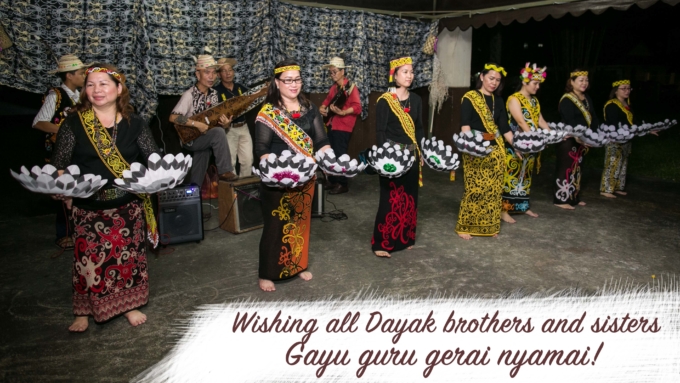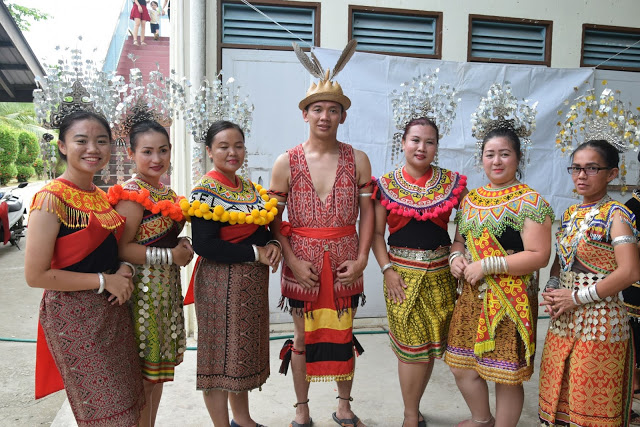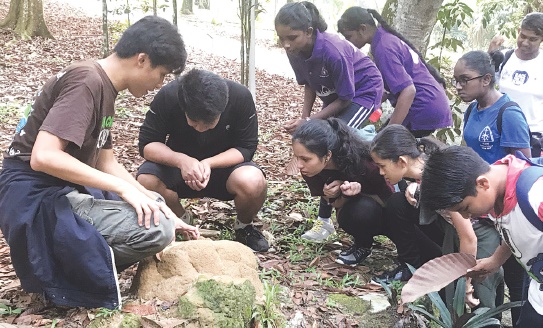
(Dalam Bahasa Malaysia)
Setiap tahun pada waktu sekarang, kita merayakan Pesta Menuai iaitu Gawai di Sarawak dan Kaamatan di wilayah jiran kita, Sabah. Gawai menandakan berakhirnya musim menuai dengan perayaan kesyukuran bermasyarakat. Sebagai umat Kristian, kita merayakan Gawai dengan memanjatkan kesyukuran kita kepada Allah dalam Gereja. Saya sentiasa kagum dengan terjemahan ‘Mass’ (dalam bahasa Inggeris) sebagai ‘Gawai Misa’ dalam bahasa Iban atau bahasa Bidayuh. Ini sememangnya wajar kerana Misa kita sebenarnya adalah Perayaan Kesyukuran.
Rumah panjang dan kampung Dayak telah mengajar saya tentang kitaran penanaman padi setiap tahun – membersih, membakar, menanam, membuang rumput-rumpai, menuai, mengasingkan kulit padi, kesyukuran dan terutamanya mengasingkan bijirin untuk penanaman seterusnya. Banyak kerja berat dilakukan sebelum kita disajikan dengan nasi yang masak di atas meja makan. Patutlah nenek-nenek kita selalu menyuruh kita untuk makan nasi sampai habis, terutamanya apabila ini adalah hasil kerja kasih dan keringat. Saya ingin berkongsi beberapa renungan dan iktibar yang kita dapat pelajari dari Gawai.
Kesyukuran kepada Allah
Bumi kita diciptakan oleh Allah yang menyediakan matahari, tanah, air dan hujan untuk kita bercucuk tanam. Di Gawai Misa, kita memanjatkan kesyukuran kepada Bapa Syurgawi, yang kita percaya akan memberikan keperluan harian kita. Sebagai orang Katolik, Perayaan Gawai kita bermula dengan doa untuk mengucapkan terima kasih kepada Allah dalam semua gereja: “Bersukacitalah senantiasa, tetaplah berdoa, mengucap syukurlah dalam segala hal.” (1 Tesalonika 5:16-18).
Hubungan Kekeluargaan
Gawai adalah masa untuk pertemuan semula keluarga. Lapangan terbang serta terminal bas dan bot penuh sesak untuk perjalanan pulang ke kampung masing-masing. Ini adalah pelawaan untuk kembali ke budaya asal usul kita sendiri, dengan peluang untuk berhubung semula dengan ahli-ahli keluarga dan rakan-taulan. Saya ingin merayu kepada ibu bapa untuk membawa anak-anak anda – terutamanya mereka yang sudah membesar di kota dan bandar – pulang dengan kerap ke kampung asal anda. Berilah peluang kepada anak-anak anda untuk mempelajari, menghargai dan berhubung semula dengan budaya asal usul mereka. Saya pasti mereka akan mengalami keramahan, sambutan daripada komuniti kampung, belajar daripada kesederhanaan hidup dan kesediaan untuk berkongsi. Kita mengajar anak-anak kita tentang keprihatinan yang ikhlas terhadap satu sama lain dan rasa syukur kepada ibu bapa dan datuk nenek yang begitu banyak berkorban demi kita. Teruskan kepulangan ini sepanjang tahun.
Kehidupan Komuniti, Kerjasama dan Perkongsian
Dunia pada hari ini meletakkan kepentingan yang amat tinggi kepada pencapaian individu dan menekankan faedah kewangan. Pada hari ini kita menghadapi dunia yang materialistik dan individualistik, di mana manusia dieksploitasi untuk keuntungan peribadi dan kebendaan. Sebaliknya, Gawai merayakan kepentingan perkongsian dalam komuniti – gotong-royong, sama-sama bekerja dan menuai di sawah. Saya amat menghormati penduduk kampung, yang tidak memiliki banyak harta benda, tetapi bermurah hati untuk membahagikan apa yang mereka miliki. Saya pernah mengalami perkongsian Kristian dan keramahan tulen di kampung-kampung.
Komitmen, Pengorbanan dan Usaha Gigih
Hasil padi diperolehi menerusi pengorbanan, usaha gigih dan komitmen selepas menjaga sawah selama setahun. Kita merayakan martabat kerja dan penghormatan bagi setiap pekerja, sama ada di sawah atay di bandar. Saint Joseph bekerja keras sebagai seorang tukang kayu dan seorang bapa untuk menyara Keluarga Suci di Nazareth. Dia mengajar kita tentang martabat kerja dan sikap menghormati manusia. Maka itu marilah kita bersedia untuk bekerja dengan tangan kita – dengan melayani keluarga kita dan bekerja untuk kebaikan bersama dalam komuniti, masyarakat dan negara kita, Malaysia.
Simpanan Untuk Masa Depan
Selepas menuai, padi baharu disimpan untuk masa depan. Saya pernah melihat lumbung (tempat menyimpan padi) besar – dengan diameter lima kaki, yang diperbuat daripada kulit kayu bulat dan diikat dengan rotan. Saya menyedari jika berlaku sebarang bencana dan kebuluran, penduduk kampung ini akan selamat manakala kita, di bandar raya, akan kelaparan kerana kekurangan makanan. Lumbung bertindak sebagai “bank”, di mana padi disimpan sebagai bekalan untuk masa depan.
Satu lagi pengalaman yang tidak dapat dilupakan dalam Misa Kesyukuran Gawai adalah melihat keluarga mempersembahkan benih padi yang diletakkan di hadapan altar. Saya akan memanjatkan doa keberkatan bagi benih padi ini sebelum saya memberinya balik kepada keluarga. Benih yang terpilih ini akan dijadikan benih untuk penyemaian dan penanaman seterusnya.
Pada waktu ekonomi yang sukar pada hari ini, Gawai mengajar kita unuk menyimpan hasil tuaian kita – pendapayan kita, dan membuat bajet dan perancangan dengan teliti untuk komitmen kewangan kita sepanjang tahun. Ia adalah seruan untuk mengawal diri daripada konsumerisme dengan membeli telefon terkini, gajet dan mengekang perbelanjaan yang tidak perlu semata-mata untuk mengikuti trend kehidupan moden. Gawai mempelawa kita untuk mengubah hati. Kita tidak mahu diatasi gaya hidup materialistik, keseronokan dan kenikmatan yang ditawarkan oleh dunia. Saya merayu kepada semua ibu bapa untuk memberikan komitmen kepada usaha menyediakan persekitaran keluarga yang baik, setia kepada satu sama lain, membuat bajet dan menabung atau memperuntukkan simpanan untuk pendidikan anak-anak kita pada masa depan.
Mengambil Berat Tentang Ekologi
Penanaman padi banyak bergantung kepada keadaan cuaca. Perubahan iklim baru-baru ini benar-benar menjejaskan hasil tuaian kita. Saya ingin menyeru kepada pendekatan pertanian yang mapan dalam usaha kita menggunakan tanah, sumber air dan sebagainya. Kita perlu memberi pelindungan dan penjagaan yang lebih baik kepada persekitaran dan ekologi kita. Sebagai orang Katolik, marilah kita mencari gaya hidup yang menuntut tanggungjawab bagi semua penciptaan, untuk melihat diri sebagai saling berkaitan dengan satu sama lain dan persekitaran. Paling utama sekali, kita mahu berada dalam solidariti Kristian dengan golongan miskin.
“Kuasa ilahiNya telah menganugerahkan kepada kita segala sesuatu yang diperlukan untuk kehidupan dan kesolehan…, supaya menerusinya kita dapat terlepas daripada korupsi yang ada dalam dunia kerana nafsu, dan boleh menjadi peserta sifat ilahi. Atas sebab inilah kita mesti berusaha sedaya upaya untuk menyokong iman kita dengan kebaikan, dan kebaikan dengan pengetahuan, dan pengetahuan dengan penguasaan diri, dan penguasaan diri dengan ketekunan, dan ketekunan dengan kesolehan, dan kesolehan dengan kasih bagi sesama, dan kasih bagi sesama dengan cinta kasih.” (2 Petrus 1:3-7)
Pada bulan Gawai ini – bersama Uskup Agung Emeritus John dan Peter, Paderi dan Religius di Keuskupan Agung Kuching – saya ingin memberi pemberkatan dan doa-doa saya bagi semua umat Katolik kita dan semua orang yang merayakan Gawai.
+ Uskup Agung Simon Poh
(In English)
Every year, during this time, we celebrate our Harvest Festival of Gawai in Sarawak and Kaamatan in our neighbouring Sabah. Gawai marks the end of the harvesting season with a communal thanksgiving celebration. As Christians, we celebrate Gawai by offering our thanksgiving to God in Church. I have always marvelled at the translation of “Mass” as “Gawai Misa” in Iban or Bidayuh. This is indeed appropriate as our Mass is really a Thanksgiving Celebration.
The Dayak longhouses and villages have taught me about annual rice cultivation cycle – clearing, burning, planting, weeding, harvesting, separating the husk, thanksgiving and especially setting aside the grains for the next planting. There is a lot of hard labour before we get the cooked rice on our table. It is no wonder that our grandmothers are always asking us to eat the last grain of rice on our plate, especially when these are from a labour of love and sweat. I would like to share some of my reflections and lessons that we can learn from Gawai:
Gratitude to God
Our land is created by God who provides the sun, earth, water and rain for our planting. At Gawai Mass, we give thanks to our Heavenly Father, trusting that he will give us our daily needs. As Catholics, our Gawai Celebration begins with prayer to thank God in all Churches. “Rejoice always, pray without ceasing, give thanks in all circumstances” (1 Thes 5:16-18).
Family Connection
Gawai is a time of family reunion. Airports, bus and boat terminals are crowded for homecoming journeys to respective villages. This is an invitation to return to one’s own cultural roots, with the opportunity to reconnect with family members and friends. I would like to appeal to parents to bring your children – especially those who have grown up in the city and towns – to return regularly to your home villages. Give your children the opportunity to learn, appreciate and reconnect with their cultural roots. I am sure they will experience the hospitality, welcome of the village community, learn from the simplicity of life and willingness to share. We teach our children sincere concern for one another and to be grateful to parents and grandparents who have sacrificed so much for us. Carry on this homecoming throughout the year.
Community Living, Cooperation and Sharing
The world today places great importance to individual achievement and emphasised monetary benefits. Today we face a materialistic and individualistic world, where people are exploited for personal and material gain. On the other hand, Gawai celebrates the importance of community sharing – gotong-royong, working and harvesting together in the field. I greatly respect these villagers, who do not possess much materially, but are generous to share what they have. I have experienced Christian sharing and genuine hospitality in these villages.
Commitment, Sacrifice and Hard work
The rice harvest has been attained through sacrifice, hard work and commitment after tending the farms for a year. We celebrate the dignity of work and respect for each worker, whether in the farm or in the city. St Joseph has worked hard as a carpenter and a father to provide for the Holy Family of Nazareth. He taught us the dignity of labour and respect for the human person. Let us then be ready to work with our hands – by serving our families and to work for the common good in our community, society and nation Malaysia.
Putting Aside Savings for the Future
After the harvest, the new padi grains are stored for the future. I have seen large granary – with diameter of 5 feet, made from circular tree bark, bound in place by rotan. I realized that should there be any calamity and famine arises, these villagers will survive while we, in the city, will starve for lack of food. The granary serves as a “bank,” with the grains being set aside as savings for the future.
Another memorable experience during Gawai Thanksgiving Mass is to see families presenting offerings of padi-grains that are placed before the Altar. I would offer a prayer of blessing for these grains after which they would be given back to the families. These selected grains will be reserved as seeds for the next sowing and planting.
In today’s difficult economic time, Gawai teaches us to set aside our harvest – our earning, and to do a careful budgeting and planning for our financial commitments throughout the year. It is a call to refrain from consumerism by purchasing the latest handphones, gadgets and curb unnecessary spending to keep up with the trends of modern living. Gawai invites us to a conversion of heart. We seek not to be overcome by materialistic lifestyle, the pleasures and enjoyment offered by the world. I implore all parents to be committed to providing a good family environment, seeking to be faithful to one another, to budget and put aside savings for the future education of our children.
Care of the Ecology
Padi-planting depends tremendously on the weather. Recent climate change has really affected our harvest. I would like to call for a sustainable agricultural approach towards using our land, water resources, etc. There has to be a greater protection and care of our environment and ecology. As Catholics, let us seek a lifestyle that entails responsibility for all Creation, to see oneself as interrelated with one another and the environment. Above all, we seek to be in Christian solidarity with the poor.
“His divine power has given us everything needed for life and godliness…, so that through them you may escape from the corruption that is in the world because of lust, and may become participants of the divine nature. For this very reason, you must make every effort to support your faith with goodness, and goodness with knowledge, and knowledge with self-control, and self-control with endurance, and endurance with godliness, and godliness with mutual affection, and mutual affection with love.”
(2 Peter 1:3-7)
In this Gawai month – together with Archbishop Emeriti John and Peter, Priests and Religious of the Archdiocese of Kuching – I would like to impart my blessing and prayers for all our Catholics and people of good will who are celebrating Gawai.
+ Archbishop Simon Poh
Article reproduced from Archdiocese of Kuching Sarawak
 Cross Luminous 0567
8 × RM 3.80
Cross Luminous 0567
8 × RM 3.80  Crucifix Pendant 0566
8 × RM 9.80
Crucifix Pendant 0566
8 × RM 9.80  Crucifix Pendant 5298
16 × RM 7.50
Crucifix Pendant 5298
16 × RM 7.50  Gold Rose Crucifix 12 cm
20 × RM 23.00
Gold Rose Crucifix 12 cm
20 × RM 23.00  Miraculous Blue Medal
2 × RM 3.00
Miraculous Blue Medal
2 × RM 3.00  Cross Luminous 0566
6 × RM 3.80
Cross Luminous 0566
6 × RM 3.80  Twins Heart Jesus of Mary 4536
2 × RM 17.50
Twins Heart Jesus of Mary 4536
2 × RM 17.50 
 Cross Luminous 0567
Cross Luminous 0567  Crucifix Pendant 0566
Crucifix Pendant 0566  Crucifix Pendant 5298
Crucifix Pendant 5298  Gold Rose Crucifix 12 cm
Gold Rose Crucifix 12 cm  Miraculous Blue Medal
Miraculous Blue Medal  Cross Luminous 0566
Cross Luminous 0566  Twins Heart Jesus of Mary 4536
Twins Heart Jesus of Mary 4536 














